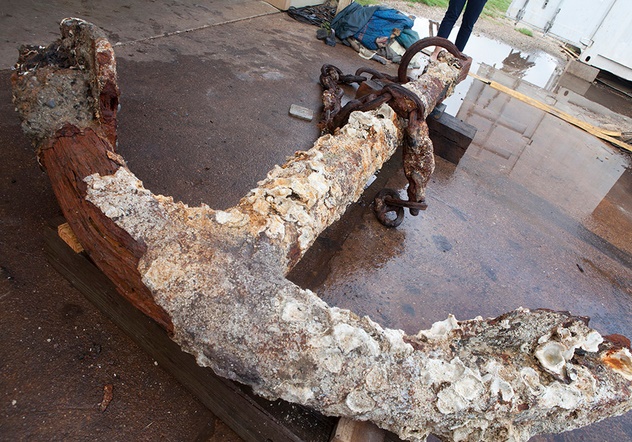Found: The lost anchor of the HMS Chatham? A&M begins verification
Image: Texas A&M University
A long-lost anchor—believed to have been missing since 1792 and thought to have belonged to the HMS Chatham when it was on an expedition in Vancouver — has made its way from the Pacific Northwest to Texas A&M University, where it will undergo extensive conservation that its owners hope will also verify its having belonged to the ship operated by British explorer Capt. George Vancouver.
The 10-foot-long anchor, weighing about 1,400 pounds, made the 2,200-mile journey to Texas A&M ‘s Center for Maritime Archaeology and Conservation in the back of a pickup truck driven by Scott Grimm and Doug Monk, the two men who have undertaken the conservation project as a fairly expensive labor of love. Grimm resides in Seattle and Monk in Port Angeles, Wash.
The anchor is now in the hands of a team headed by Jim Jobling, a research associate at the Texas A&M center’s Conservation Research Laboratory, a veteran in tackling such tasks.
Jobling estimates work on the anchor will take 18 to 24 months, at which time Grimm and Monk will retrieve it for the trek back to the Northwest and hopes of finding a museum or other location for its permanent display.
“Our goal is definitely to keep it in the Northwest,” Grimm said.
“Also, we’re confident the anchor is from the HMS Chatham, and we’re confident—certainly hope—that the conservation work at Texas A&M will uncover some markings that show beyond a shadow of a doubt that it belonged to the (British) crown,” he added.
Jobling, who has worked at the renowned research lab for 30 years, said the anchor will be an “interesting project,” one that could have a bearing on Puget Sound history.
“We welcome such opportunities to help conserve major artifacts of historic significance and preserve them for posterity,” he noted. It also gives graduate students in the Nautical Archaeology Program, a hands-on opportunity to learn practical artifact conservation.
The anchor was pulled from its resting place last month by a crane aboard a barge amid less-than-ideal weather conditions and was put on display briefly before arrangements were finalized to send it to Texas A&M.
The anchor was reported lost, after having become wedged against a large rock formation. The hemp anchor cable then snapped, as it was not strong enough to hold the ship in the high current off Whidbey Island, according to reports. The ship’s log mentions that the recovery effort failed. When the anchor was recovered recently, the remains of a small grapnel were found lodge in the chain.
#TAMUresearch


